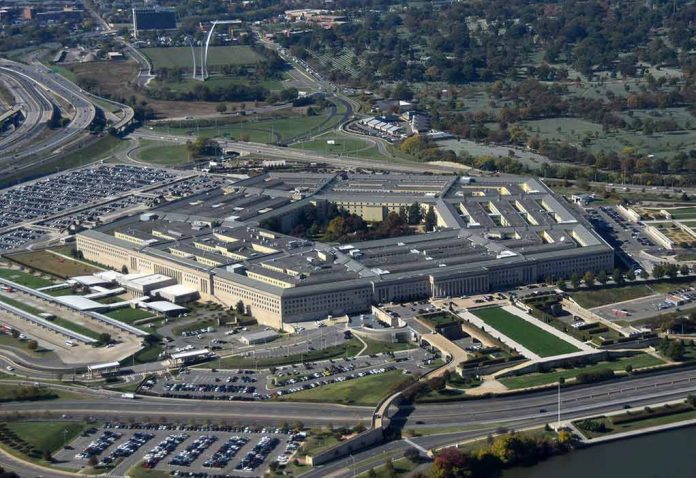🔴 Website 👉 https://u-s-news.com/
Telegram 👉 https://t.me/usnewscom_channel
Elon Musk’s scathing critique of the F-35 fighter jet program exposes a $2 trillion boondoggle that could revolutionize military spending.
At a Glance
- Elon Musk labels F-35 program “obsolete” and unnecessarily complex
- Program costs soar to $485 billion with total lifetime cost exceeding $2 trillion
- Musk argues for shift to drone warfare, citing efficiency and reduced pilot risk
- Pentagon defends F-35 amid criticism of rising costs and performance issues
- Musk and Ramaswamy to advise on government efficiency, targeting Pentagon spending
Musk’s Scathing Critique of the F-35 Program
Elon Musk, the tech mogul known for disrupting industries, has set his sights on the Pentagon’s most expensive project to date: the F-35 fighter jet program. In a series of bold statements, Musk has labeled the makers of these costly jets as “idiots,” arguing that the F-35 is not only obsolete but also a prime example of government waste. His criticism comes at a crucial time as he prepares to advise the White House on reducing federal spending, potentially reshaping the future of military technology and expenditure.
Musk’s primary argument centers on the F-35’s design flaws, which he claims stem from attempting to meet too many requirements simultaneously. This approach has resulted in an aircraft that is not only expensive but also unnecessarily complex. The entrepreneur didn’t mince words when describing the jet, going so far as to call it a “shit design” that puts pilots at unnecessary risk in an age where unmanned drones could potentially perform the same tasks more efficiently and with less danger to human life.
The F-35 design was broken at the requirements level, because it was required to be too many things to too many people.
This made it an expensive & complex jack of all trades, master of none. Success was never in the set of possible outcomes.
And manned fighter jets are… https://t.co/t6EYLWNegI
— Elon Musk (@elonmusk) November 25, 2024
The Staggering Costs of the F-35 Program
The financial implications of the F-35 program are staggering. Initially projected at a lower cost, the program’s price tag has ballooned to $485 billion, with expectations that it will exceed $2 trillion over its lifetime. This astronomical figure includes the production of over 3,000 jets, with an expected service life until 2088. The U.S. Government Accountability Office has reported a projected cost increase of over 40% for the F-35 program, partly due to ongoing reliability issues.
“The Pentagon recently failed its seventh consecutive audit, suggesting that the agency’s leadership has little idea how its annual budget of more than $800 billion is spent,” Musk and Ramaswamy wrote.
This damning statement highlights the lack of fiscal responsibility and transparency within the Department of Defense, further fueling the argument against such expensive and potentially outdated programs like the F-35. The failure to pass audits raises serious questions about the Pentagon’s ability to manage taxpayer dollars effectively, especially when it comes to high-cost, long-term projects.
The Future of Warfare: Drones vs. Fighter Jets
Musk’s vision for the future of warfare leans heavily towards unmanned systems. He argues that drones are not only more cost-effective but also more adaptable to modern combat scenarios. The entrepreneur points to recent conflicts, such as the Russia-Ukraine war, as evidence of the growing importance and effectiveness of drone technology in military operations. This shift could potentially save billions in taxpayer dollars while reducing the risk to human pilots.
Despite Musk’s criticisms, the Pentagon stands firm in its defense of the F-35 program. A spokesperson for the Department of Defense stated, “We have combat capable aircraft in operation today and they perform exceptionally well against the threat for which they were designed. Pilots continually emphasize that this is the fighter they want to take to war if called upon.”
This steadfast support for the F-35 program, despite mounting evidence of its shortcomings, exemplifies the resistance to change within the military-industrial complex. It raises questions about whether the Pentagon is truly open to innovative solutions that could potentially save lives and reduce costs.
Implications for Future Military Spending
As Musk and Vivek Ramaswamy prepare to advise on government efficiency, their focus on military spending could lead to significant changes in how the U.S. approaches defense technology. Their appointment to lead the Department of Government Efficiency (DOGE) signals a potential shift towards more cost-effective and innovative military solutions. However, the challenge lies in overcoming entrenched interests and bureaucratic inertia that have long dominated Pentagon spending decisions.
The debate surrounding the F-35 program is more than just about a single aircraft; it’s a reflection of broader issues within government spending and military procurement. As the U.S. faces evolving global threats and fiscal challenges, the need for efficient, effective, and adaptable defense solutions has never been more critical. Musk’s outspoken criticism may be the catalyst needed to spark a serious reevaluation of how America invests in its military future, potentially leading to more innovative and cost-effective approaches to national defense.

